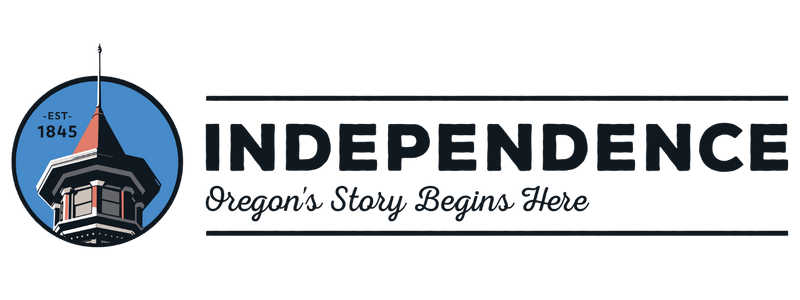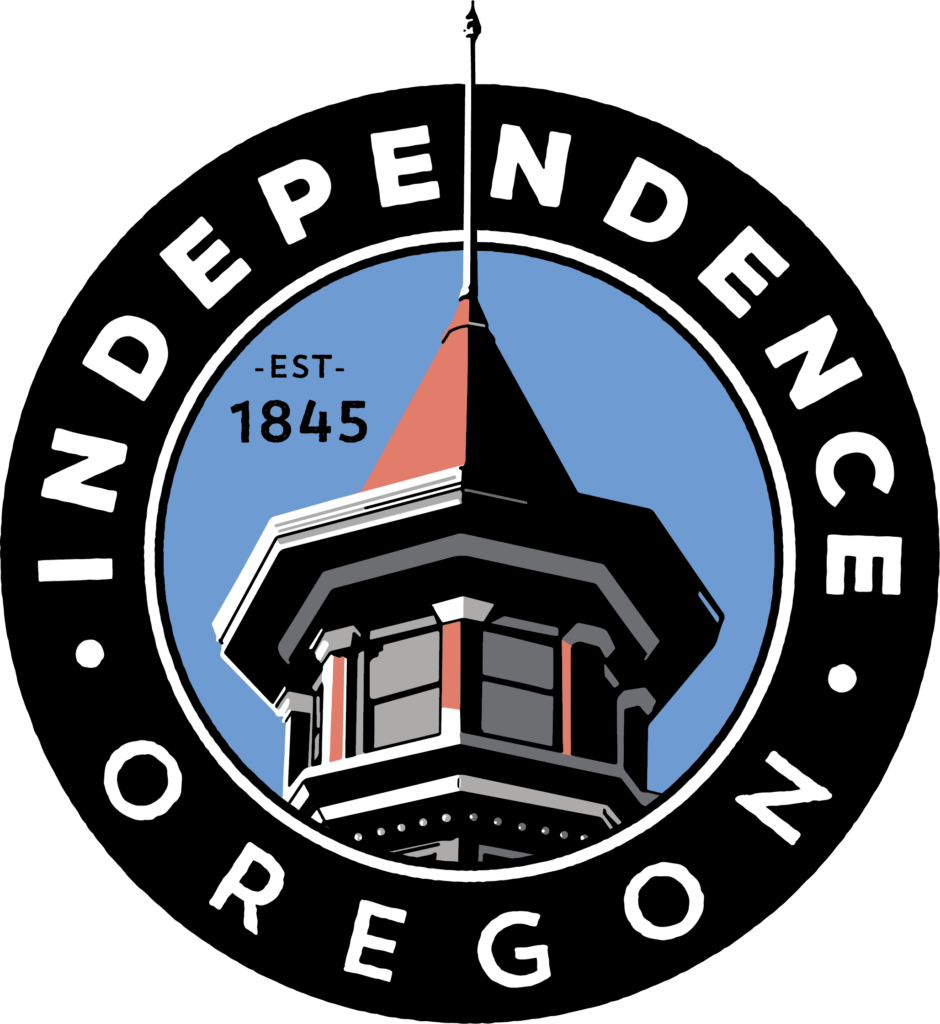Working Hard to Provide High Quality Water
The Water Department of Independence is committed to providing the community with high-quality water service that is both dependable and efficient. Our team is dedicated to ensuring that the city provides residents with the highest quality water possible.
Reliable Access to Quality Water
The City is responsible for ensuring its residents have access to water for their daily needs and fire safety. To achieve this, it operates and maintains a water system that sources its water from two separate wellfields, each with ten groundwater wells, a water treatment plant, reservoir storage, and a booster pump station. The City also has four ground storage reservoirs, three booster pump stations, and distributes drinking water through a network of approximately 36.8 miles of watermains.
There is a total of approximately 194,200 feet (36.8 miles) of mainline pipe in the City’s existing distribution system. Mainlines are the large carrier pipes that feed the service line pipes to all residential, commercial and industrial buildings. The City has mainline pipes ranging in size from 2-12” in diameter.
The City currently has approximately 2,700 connections or service lines made up of copper, galvanized and polyvinyl chloride (PVC). Copper and galvanized are being phased out due to age or degradation of the metals in the pipes. Since 2015, a little over 500 water services have been replaced by Public Works with PVC and around 100 services have been replaced by contractors when mainlines have been replaced. We continue our efforts to be proactive and replace 15-75 service lines in-house each year.
Your Content Goes Here
Water Conservation: Simple and Effective Tips for Preserving both your Wallet and the Environment
Water is a precious resource that should be used with care. You might be surprised to learn that the average American family of four consumes approximately 400 gallons of water every day. However, a significant amount of this water goes to waste. For instance, the average toilet in the US uses between 5-7 gallons per flush, while a typical shower consumes as much as 5 gallons per minute. Even worse, leaky toilets can waste as much as 200 gallons of water per day.
By conserving water, you can cut down on your water bills and simultaneously contribute to a healthier environment. Here are some simple yet effective tips that can help you get started:
Water-Saving Tips for Inside the Home
Save water and reduce your water bill by following these simple tips:
- Refrain from using the toilet as a wastebasket, wasting water with every flush.
- Regularly check toilets and faucets for leaks and immediately repair any issues.
- Operate your dishwasher only when it’s fully loaded.
- Wash only complete laundry loads or adjust the water level setting to match your load size.
- Avoid running the water continuously when brushing your teeth or shaving. By keeping the tap turned on at full force, shaving consumes 20 gallons of water, while teeth-brushing uses 10.
- Limit your shower time or decrease the water volume when taking a bath. Filling a tub calls for approximately 36 gallons of water, whereas a five-minute shower with a water-conserving showerhead consumes only 15 to 25 gallons.
- Consider investing in water-efficient toilets, faucets, and showerheads to save water in the long run.
Simple Ways to Care for Your Yard and the Environment
Maintaining your lawn doesn’t mean harming the environment. Here are some tips to keep your garden green while minimizing your ecological impact:
- Instead of maintaining a green lawn, choose native or Pacific Northwest-friendly plants and trees. This will help preserve the natural vegetation, and make your yard more resistant to insects and disease.
- Enrich your soil with organic materials such as peat moss or compost. This will help your yard retain water and ensure that it’s aerated.
- Use a drip system or a sprinkler with a low application rate to water your yard and garden efficiently. Established grass only needs an inch of water per week.
- Water your lawn and garden in the early morning or evening to prevent evaporation.
- Do not water the driveway, sidewalk, or street; limit watering to your lawn and garden only.
- To retain moisture and prevent weed growth, mulch around plants and trees.
- Use a broom instead of a hose to clean driveways and sidewalks, saving water and reducing waste.
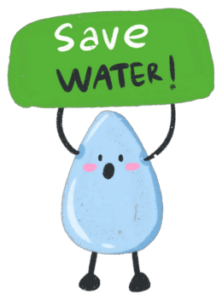
Making a Positive Impact
It’s up to all of us to improve our community and the environment. By taking action, we can make a difference. Consider these water conservation resources to kick-start your efforts:
Discover 100 water-saving techniques courtesy of ‘Water Use It Wisely’.
Calculating Drips – WaterWiser Drip Calculator
The WaterWiser Drip Calculator, created by the American Water Works Association, is a useful tool to measure how much water is wasted from leaks in your home or business. Simply input the necessary details to determine the amount of water lost per day, month, or year.
A Guide to Conserving and Efficiently Using Water
Learn about the advantages of WaterSense – a US EPA partnership program that suggests water-saving methods for households and businesses.
Simple Steps to Conserve Water
If you’re passionate about saving water, there are many actions you can take to make a difference. The US Environmental Protection Agency offers a wealth of resources and information on their website to help you get started as a water conservationist.
Observing International World Water Day
On March 22nd of each year, individuals around the world unite to observe International World Water Day. This global event promotes awareness of the significance of freshwater and encourages sustainable management of our water resources.
Water Wiser: Your Comprehensive Online Resource for Water Conservation and Drinking Water Industry
The American Water Works Association proudly presents Water Wiser – an interactive website equipped with education, news, and other resources that cater to the information needs of water conservation communities and the drinking water industry.
Exploring the World of Water through Educational Programs for Children and Families.
- 2023 Annual Drinking Water Report – English & Spanish
- 2022 Annual Drinking Water Report
- 2022 Annual Drinking Water Report – Spanish
- 2021 Annual Drinking Water Report
- 2021 Annual Drinking Water Report – Spanish
- 2020 Annual Drinking Water Report
- 2019 Annual Drinking Water Report
- 2018 Annual Drinking Water Report
- 2017 Annual Drinking Water Report
- 2016 Annual Drinking Water Report
- 2015 Annual Drinking Water Report
- 2014 Annual Drinking Water Report
- 2014 Annual Drinking Water Report Spanish
Annual Water Quality Reports
Water Quality Reports, also known as Consumer Confidence Reports (CCRs), are an essential tool for learning about the water you drink. By law, all community water suppliers in the United States are required to provide these reports to their customers.
The reports are designed to provide you with important information about the quality of your drinking water and the services we offer. Our top priority is to provide you with a safe and reliable supply of drinking water, and we are committed to implementing strategies to enhance our water treatment process and safeguard our water resources.
We want you to be aware of the efforts we make to maintain the quality of your water, and we encourage you to review the Water Quality Report to stay informed about the health and safety of your water supply.
Annual Water Quality Reports
Water Quality Reports, also known as Consumer Confidence Reports (CCRs), are an essential tool for learning about the water you drink. By law, all community water suppliers in the United States are required to provide these reports to their customers.
The reports are designed to provide you with important information about the quality of your drinking water and the services we offer. Our top priority is to provide you with a safe and reliable supply of drinking water, and we are committed to implementing strategies to enhance our water treatment process and safeguard our water resources.
We want you to be aware of the efforts we make to maintain the quality of your water, and we encourage you to review the Water Quality Report to stay informed about the health and safety of your water supply.
- 2022 Annual Drinking Water Report
- 2022 Annual Drinking Water Report – Spanish
- 2021 Annual Drinking Water Report
- 2021 Annual Drinking Water Report – Spanish
- 2020 Annual Drinking Water Report
- 2019 Annual Drinking Water Report
- 2018 Annual Drinking Water Report
- 2017 Annual Drinking Water Report
- 2016 Annual Drinking Water Report
- 2015 Annual Drinking Water Report
- 2014 Annual Drinking Water Report
- 2014 Annual Drinking Water Report Spanish
Safeguarding The Public’s Water Supply
The City of Independence Water Department is committed to ensuring that the public water supply is safe and free from contamination. This is achieved by implementing the Backflow Prevention & Cross Connection Control Program, which is mandated by the state to prevent pollution and contamination of the water supply.
Importance of Backflow Prevention and Its Mechanisms
Backflow is a serious issue where water flows back into the drinking water system through a cross connection, instead of moving in its intended direction. Two main ways backflow can occur are through backsiphonage and backpressure:
- Backsiphonage: This occurs when the pressure in the drinking water system drops below normal. Activities such as water line flushing, fire fighting, or water main breaks can trigger this type of backflow.
- Backpressure: This type of backflow happens when the pressure in a customer’s piping system is higher than that of the drinking water system. Backpressure is common in commercial applications that involve pumps, high-rise buildings, or boilers.
Backflow can lead to water contamination with pollutants, which can affect public health. Backflow from a private plumbing system can also flow into a public water supply or a building’s plumbing system, contaminating the water for other users. Installing a backflow prevention device is crucial to safeguard plumbing systems and public water supplies from contamination.
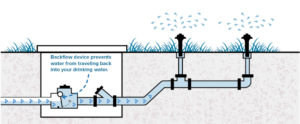
Understanding Cross-Connections and their Impact on Public Water Systems
A cross-connection can occur when a public water system or a consumer’s drinking water system is connected to a non-potable water source or system. This can result in contamination and jeopardize the safety and health of the public. Here are some common examples of cross-connections:
- Hot tubs
- Auxiliary water systems (wells)
- Hoses submerged in polluted or contaminated water
- Secondary irrigation water sources (such as wells or ponds) pumped into an irrigation system directly connected to the drinking water supply system
- Heating boilers with treatment chemicals added to prevent internal corrosion being connected directly to the water supply for make-up water
- Lawn sprinkler systems directly connected to the water supply system
- Fountains or swimming pools directly connected to the water system for filling
Backflow, the reversal of flow caused by a change in pressure within the water supply piping, can cause contaminated water to flow back into the drinking water supply system. Although public water systems are typically pressurized to maintain a continuous flow of water to your tap, unanticipated events, such as firefighting or water main breaks, can cause pressure changes that result in backflow.
To prevent cross-connection contamination caused by backflow conditions, backflow prevention devices are installed
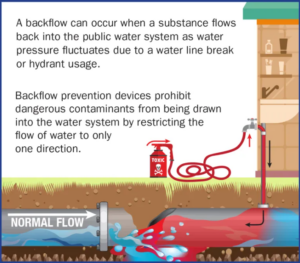
Backflow Prevention Assembly Testing Requirements in Oregon
In Oregon, it is mandatory that all backflow prevention assembly testing be conducted by a Backflow Assembly Tester who is certified by the Oregon Health Authority (OHA).
Please submit all final testing information to publicworks@ci.independence.or.us
Independence Water Department’s Backflow Prevention & Cross Connection Control Program: A Guide to Compliance
To ensure the safety and quality of the water supply, the Independence Water Department requires all customers to comply with the following guidelines:
When to Test
- After initial installation
- After any repair, replacement, or relocation
- Each year by a certified backflow assembly tester
Reminder Letter
- Customers with backflow assemblies that require testing will receive a yearly reminder letter from the Public Works Department.
Consequences of Noncompliance
Failure to conduct the required yearly backflow prevention assembly test will result in denial or discontinuation of water service.
Steps for Compliance
- Contact a State of Oregon approved Certified Backflow Assembly Tester.
- Schedule a test.
- Provide your account number to the tester.
- Your account number is listed on the reminder to test letter you received from the Independence Water Department and your City of Independence Utility Bill.
- You can request your account number at 503-837-1181 or by e-mail.
- Your account number provides testers with information about the assembly(s) at your location, such as make, model, and serial number. It does not identify you or provide your contact information.
- Once the test is complete, the certified tester will submit your results. The test can also send you a copy of the report.
Confirming Receipt of Test Report
To confirm that Independence Water has received your backflow test report, you can:
- Call 503-837-1181
- Email Independence Water
- Visit 555 S Main St. Independence OR 97351
Not Testing a Backflow Assembly after Receiving a Notification: What Happens?
If you’ve received a notification to test your backflow assembly, it is crucial to do so. However, if for some reason you fail to test it, here are the two possible courses of action:
- If the assembly is a plumbing code assembly, the City of Sherwood may require you to install, test and maintain a backflow assembly behind the water meter to safeguard the public water system. This will incur fees.
- Your water service may be terminated to protect the public water system.
Installing a Backflow Preventer
Received a letter regarding the installation of a backflow preventer? The Independence Water Department suggests contacting a licensed plumber to assist with the installation process. If you choose to install it yourself, a plumbing permit is mandatory. Contact the City of Independence Building Department at 503-837-1177 or email our Building Permits Team for further guidance and instructions.
Determining if a Backflow Preventer is Necessary
Ways to Prevent Public Water System Contamination Due to Backflow
- Irrigation systems:
- Install an approved backflow assembly, ensure it is functioning properly, and test it yearly.
- Swimming pools and hot tubs:
- Install a hose bib vacuum breaker on the faucet to protect the water supply if you fill these units with a hose.
- Residential boilers:
- Install an approved backflow assembly, ensure it is functioning properly, and test it yearly.
- Private wells:
- Do not connect well systems to a public water system. If it is connected, install a backflow assembly at the meter, ensure it is functioning properly, and test it yearly.
Flushing for Quality, Reliability and Safety
Independence’s Water utilizes conventional, automatic, and unidirectional flushing methods to ensure that water quality and reliability are maintained, more than 300 miles of water main pipes that deliver water to homes and businesses are cleaned, and adequate water flow is available for firefighters.
Please be aware that flushing may cause temporary discoloration of water and affect water pressure. However, this does not pose any health risks.
What to Expect During Water Flushing Procedures
Before flushing, the following will take place:
- Crews will gather their equipment and vehicles near a fire hydrant in the street. Cones and flaggers will be present, if necessary, to guide the public safely around the flushing area.
- Notification signs will be posted on the streets in the flushing area.
- Vehicles obstructing valves will receive no parking postcards.
- No parking signs will be posted, if required.
During the flushing procedure:
- Pedestrians may witness a significant amount of water being released from water mains through a fire hydrant, which will eventually drain into the City’s Stormwater System.
- Water service will not be disrupted, and you can continue to use water while flushing is in progress.
- Flushing may result in temporary water pressure fluctuations and sediment disturbance in the pipeline, potentially causing discolored water at your taps. While the discoloration is not hazardous to your health, we recommend that you:
- Wait until flushing is finished before using your washing machine or dishwasher.
- Flush all your taps for up to 10 minutes to clear the pipes after flushing procedures are finished.
- Clean sediment from faucet aerators, the small screens attached to the base of faucet spouts.
Please drive carefully around flushing crews and treat them like any other road construction crew.
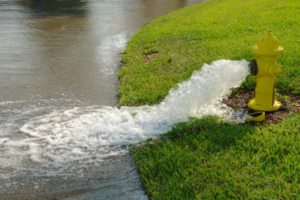
Water main flushing is scheduled throughout the year, from Monday to Friday, between 8 am and 5 pm. Occasionally, flushing activities may occur outside of these hours as required. The duration of the flushing process, which depends on the main’s age, type, and size, as well as the amount of sediment buildup, can range from 20 minutes to an hour.
Maintaining Clean and Safe Water Supply through Flushing of Independence’s Water Mains
To ensure that the water supply is free from impurities, flushing of water mains is essential. Over time, sediment from mineral deposits and organic matter can accumulate in water mains, leading to a reduction in water flow, discoloration, and taste issues. Independence Water has implemented types of flushing techniques to address these issues:
- Conventional: Water is released from the water main through fire hydrants to remove any accumulated buildup.
- Unidirectional: A high-velocity hose is attached to a fire hydrant, and valves are opened to flush out an isolated section of the water main pipe.
- Blow-off: Water is released from a specific point in the water main to remove any accumulated buildup.
After flushing, the water is cleared of chlorine before being drained into the City’s stormwater system.
A Water Leak: Concealing its Presence
Undiscovered leaks can be a major problem, both functionally and financially.
The homeowner is responsible for maintaining the water service line that runs from the water meter to their residence. Meanwhile, the City of Independence Water Department takes care of water mains and meters.
Responsibility for Leaks: Who Takes Charge?
When it comes to fixing leaks, there are two parties involved: the property owner/homeowner and the Independence Water Department. It all depends on where the leak is located:
- If the leak is in the water supply line (lateral), which is situated between the water meter and the residence, then the property owner/homeowner is responsible for fixing it.
- On the other hand, if the leak is in the water meter leading from the water main located in the street to the meter, then the Independence Water Department takes charge of the repairs.
Is it possible for the Independence Water Department to repair a leak on the homeowner’s side of the meter?
- Unfortunately, the Independence Water Department is only authorized by the state to work on the public water system. The homeowner’s side of the meter, which is considered private, can only be serviced by licensed plumbers.
Discover How to Save Money and Water by Locating and Repairing Leaks
A leak can cause significant harm to both your wallet and the environment, but there is a way to stop it. Using your water meter is an effective method to identify leaks and take the appropriate steps. Follow these instructions:
- Verify that all taps and outlets in your home and yard are turned off.
- Open your water meter box and take note of the meter.
- Observe the readout on the water meter, which alternates between “Read” (total gallons consumed) and “Rate” (water flow through the meter at the moment).
- If everything is turned off, a “Rate” reading of “0,000” indicates there are no leaks, but a “Read” number will always be present.
- If there is a number other than numerous zeroes, a leak is present.
Property owners and homeowners who require assistance locating a leak may contact the Independence Water Department by phone or email at 503 837-1181, publicworks@ci.independence.or.us to request a leak check. Trained staff will assess the situation and determine whether a professional plumber is necessary to repair any leaks. Homeowners are advised against attempting to fix leaks on their own.
How to Identify the Location of a Leak in Your House
If you discover a leak, the first step is to determine whether it’s inside or outside of your home. Follow these steps to identify the location:
- Find your shut-off valve, which may be located in the following places:
- In the garage where the water line enters the wall or ceiling, near the water heater or laundry hookup.
- In the crawl space, where the water enters the home.
- Outside near the foundation, often protected by a concrete ring or clay pipe.
- Turn the shut-off valve to the “off” position to stop the flow of water into your home.
- Check the meter outside of your house.
- If the flow readout still shows a number besides “0,000,” the leak is likely in the service line outside.
- If shutting off the flow to the house results in a “0,000” reading, then the leak is inside the house. Start by checking the toilet, as this is the most common source of leaks.
If you’re unable to locate the leak, it’s best to call a plumber for assistance.
Limitations of Water Department: Private Property Locates Unavailable
Please note that the Independence Water Department is unable to locate any underground utilities on private property. To assist customers with identifying their waterline, private utility locators can be contacted to provide marking and locating services.
Requesting Water Service Shut-Off for Plumbing Repairs
In case of significant water leaks or plumbing repairs, shutting off the water at your property may be required. During business hours, please contact the Independence Water Department at 503-837-1181 and ask for a water service shut-off at the meter.
Keep in mind that customers are not authorized to tamper with the water meter. If the meter or shut-off is damaged, customers will be held responsible and charged for the repairs.
